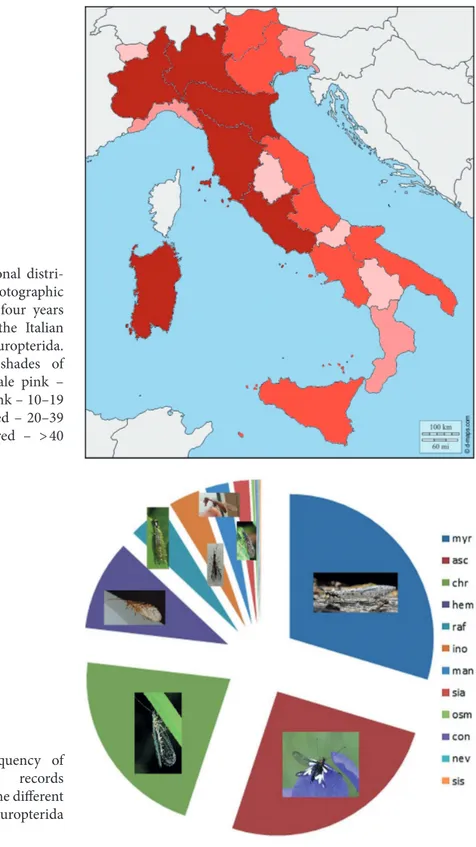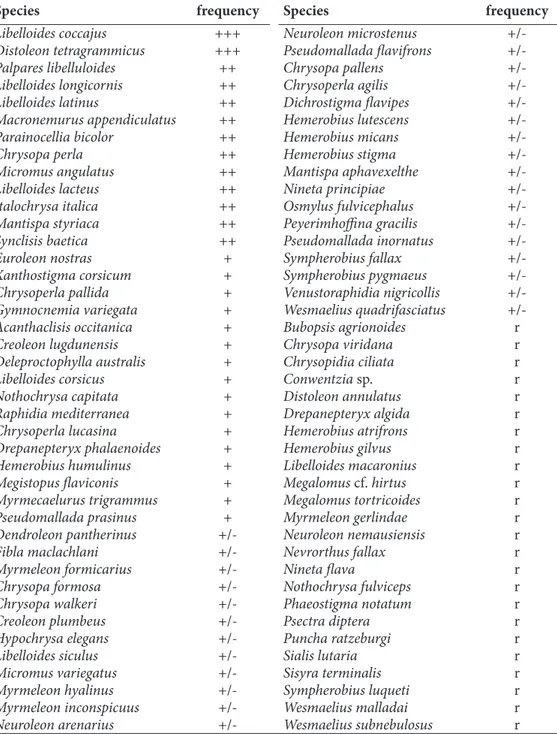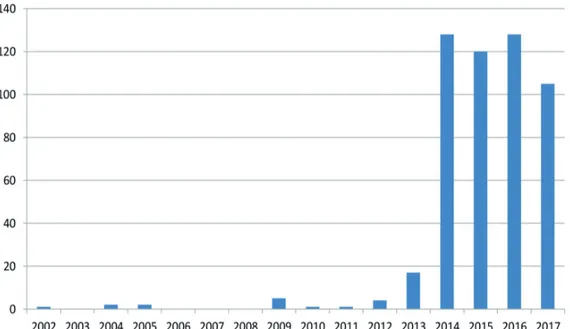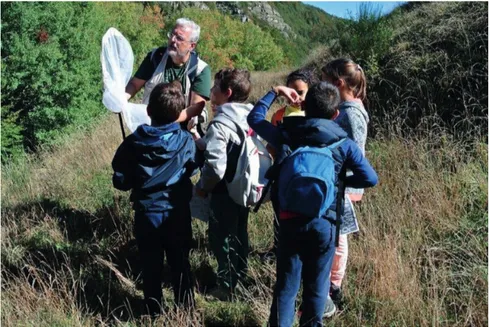Lacewings and Citizen science in Italy:
a young but very promising relationship
Agostino LetardiENEA, Lungotevere Thaon di Revel, 76, 00196 Roma, Italy; [email protected] Received 28th August 2018; revised and accepted 13th August 2019
Abstract. Citizen science is growing as a field of research with contributions from diverse
disci-plines, promoting innovation in science, society, and policy. Citizen science platforms (i.e., iNat, https://www.inaturalist.org/) and capacity-building programmes foster the visibility of projects and establish networks for knowledge exchange within and among members of the citizen sci-ence community. Several recent events of citizen scisci-ence in Italy (mainly by means of bioblitzes) have given a new perspective to the knowledge of Neuropterida in Italy.
Introduction
As a scientist, I have continuously been involved in training activities and in engag-ing the public in scientific subjects. Entomology, but more generally the dissemination of scientific knowledge, and social commitment have always been two sectors I have walked together. For this reason, one of the first objectives that I gave myself in the study of Neuropterida was to create a web site to disseminate information to an Italian audience: this web site (URL: http://neurotteri.casaccia.enea.it/), online since 2000, has been updated to 03.viii.2018. From the beginning, it has been perfectly clear to me that researchers benefit from using the Internet on a one-to-one basis (e-mail, File Transfer Protocol), a one-to-many basis (discussion groups, Internet conferences), and from ac-cessing large databases of knowledge (Young et al. 2014).
Although only a few researchers have devoted themselves intensely to the study of Neuropterida in Italy, collaboration with many colleagues has led to a widespread and more in-depth knowledge. Meanwhile, several of us have also dedicated ourselves to the dissemination of scientific knowledge by creating basic texts, contributing to the knowl-edge of the value of biodiversity, in addition to establishing and taking care of a vast audience of people who have contributed over time to help document the presence of Neuropterida in nature (Nicoli Aldini 2007; Pantaleoni et al. 2011; Letardi 2016). This convergence of interests between a wide audience of naturalists, who through vari-ous web media (Forums, Social Media, Mailing Lists), send daily comments, often ac-companied by photographs, has enabled us, the Italian specialists of Neuropterida, to greatly accelerate the advance of knowledge of these insects for Italy and beyond. But this collaboration between entomologists and passionate nature photographers has not exhausted our intention for wider engagement, and the citizen science sector has always opened up new and promising developments (McKinley et al. 2017; Tredick et al. 2017).
Agostino Letardi
Materials and methods
In order to quantify the recent contribution that active citizenship has provided to the development of knowledge in the neuropterological field, data collected between 2014 and 2017 has been analysed. Every semester, I am collecting, from the main Italian entomological and naturalist forums, social media and other sources, reports relating to species of Neuropterida photographed in Italy. Each report is evaluated by expert entomologists and only those deemed plausible are recorded.
Results and discussion
Within the four years, a total of 570 valid reports were collected, relating to 82 taxa – almost half of the Italian species of Neuropterida. Of these, almost 500 were attributed to species level, whereas the remaining 70 were only able to be determined to genus level (Table 1). As was expected, the owly sulphur Libelloides coccajus (Denis & Schif-fermüller, 1775) and the spotted antlion Distoleon tetragrammicus (Fabricius, 1798) are the most frequently photographed species; some other common antlions, owlflies, green and brown lacewings, the inocellid snakefly Parainocellia bicolor (A. Costa, 1855) and the charismatic mantidfly Mantispa styriaca (Poda, 1761) are also frequently pho-tographed. Huge numbers of photographs of the common green lacewing, i.e., the Chryso perla species-complex were received, a group very rarely determinable to species level on the basis of a photograph: nevertheless some species of that complex are listed in Table 1.
An elaboration of the regional distributions of the photographic records is illustrated in Figure 1. Considering the high biodiversity of Neuro pterida in that region (Letardi & Scalercio 2018), we must regard Calabria as an underestimated area by our naturalist photographers.
Between 2014 and 2017, almost all the families of Neuropterida present in Italy have been reported by the Italian naturalist photographers, except for Dilaridae and Berothi-dae; however, more than three-quarters of the total number of reports are antlions, owl-flies or green lacewings (Fig. 2).
From analysing the data of the four-year period, it can be observed that the reports often refer to the same year that the photo was taken, or to the years just before (Fig. 3). Therefore unlike the study of museum material this source of information provides up-dated data on the current state of the habitats from which these reports come from.
Results of this survey give a useful contribution to updated knowledge about the re-gional distribution of Neuropterida in Italy.
Nevertheless, if the ‘parterre’ of naturalist photographers has greatly expanded in Italy in recent decades resulting in hundreds of reports every year for a group of insects considered ‘minor’ like the Neuropterida, the primary task of every scientist of this country should not be forgotten, i.e., to contribute to the growth of a basic collective knowledge of the value of biodiversity in Italy.
Figure 1. Regional
distri-bution of photographic records in the four years 2014–2017 of the Italian species of Neuropterida. The different shades of red indicate: Pale pink – < 10 records; pink – 10–19 records; light red – 20–39 records; dark red – > 40 records.
Figure 2. Frequency of
photographic records 2014– 2017 of the different families of Neuro pterida in Italy.
Agostino Letardi
Table 1. Frequency of specific photographic reports of the Italian species of Neuropterida in the
four-year period 2014–2017. +++ – more than 40 times; ++ – between 10 and 20 times; + – less than ten times but on average more than one time per year; +/- – more than one time per year on average but more than one record; r – only one record in the four-year period 2014–2017.
Species frequency Libelloides coccajus +++ Distoleon tetragrammicus +++ Palpares libelluloides ++ Libelloides longicornis ++ Libelloides latinus ++ Macronemurus appendiculatus ++ Parainocellia bicolor ++ Chrysopa perla ++ Micromus angulatus ++ Libelloides lacteus ++ Italochrysa italica ++ Mantispa styriaca ++ Synclisis baetica ++ Euroleon nostras + Xanthostigma corsicum + Chrysoperla pallida + Gymnocnemia variegata + Acanthaclisis occitanica + Creoleon lugdunensis + Deleproctophylla australis + Libelloides corsicus + Nothochrysa capitata + Raphidia mediterranea + Chrysoperla lucasina + Drepanepteryx phalaenoides + Hemerobius humulinus + Megistopus flaviconis + Myrmecaelurus trigrammus + Pseudomallada prasinus + Dendroleon pantherinus +/-Fibla maclachlani +/-Myrmeleon formicarius +/-Chrysopa formosa +/-Chrysopa walkeri +/-Creoleon plumbeus +/-Hypochrysa elegans +/-Libelloides siculus +/-Micromus variegatus +/-Myrmeleon hyalinus +/-Myrmeleon inconspicuus +/-Neuroleon arenarius +/-Species frequency Neuroleon microstenus +/-Pseudomallada flavifrons +/-Chrysopa pallens +/-Chrysoperla agilis +/-Dichrostigma flavipes +/-Hemerobius lutescens +/-Hemerobius micans +/-Hemerobius stigma +/-Mantispa aphavexelthe +/-Nineta principiae +/-Osmylus fulvicephalus +/-Peyerimhoffina gracilis +/-Pseudomallada inornatus +/-Sympherobius fallax +/-Sympherobius pygmaeus +/-Venustoraphidia nigricollis +/-Wesmaelius quadrifasciatus +/-Bubopsis agrionoides r Chrysopa viridana r Chrysopidia ciliata r Conwentzia sp. r Distoleon annulatus r Drepanepteryx algida r Hemerobius atrifrons r Hemerobius gilvus r Libelloides macaronius r Megalomus cf. hirtus r Megalomus tortricoides r Myrmeleon gerlindae r Neuroleon nemausiensis r Nevrorthus fallax r Nineta flava r Nothochrysa fulviceps r Phaeostigma notatum r Psectra diptera r Puncha ratzeburgi r Sialis lutaria r Sisyra terminalis r Sympherobius luqueti r Wesmaelius malladai r Wesmaelius subnebulosus r
Figure 3. Number of records of Neuropterida species per year in Italy.
Everything started from the classic question: how often does the public get to see sci-entists having fun doing science? And what if everyone who comes to watch, young or old, went away with a much better understanding of biodiversity? This happens every year in many North American, Australian, and European locations. It’s called a BioBlitz. From 2012, I have dedicated myself to all the bioblitzes that I have been able to attend. Since then, every year, I have attended 3–5 events of this kind, these have had an ex-tremely varied participation (from hundreds of people to a few couples with children), with school groups, organized groups and occasionally single people (Fig. 4). Through-out these years, and thanks to this type of engagement between science and citizenship, I have established a wide network of relationships that have often continued even after the event itself. Over time, this commitment of mine has always convinced me that, overall, the innovative potential of citizen science should embrace the manifold exper-tise of participants with different backgrounds across different disciplines, and should incorporate opportunities to work at the science-policy interface and thereby gaining new perspectives. Citizen science needs to be considered as a suitable approach to face general issues like global challenges as well as basic knowledge about insects (Hecker et al. 2018).
A crucial aspect is certainly the role that this approach can bring to the diffusion of knowledge on Neuroptera in Italy. In this sense the choices for optimal communication are crucial. The widespread use of technical tools such as smartphones has been a great help in this regard. There are many actions, projects and research that have started up in Italy in this sense (Fig. 5).
Agostino Letardi
Figure 5. Actions, projects, and research recently started up in Italy about the diffusion of
sci-entific knowledge.
Citizen science is primarily a means of extended knowledge-gathering. It is important and timely to consider the larger implications of citizen science: as a way of developing new knowledge practices, shifting the institutional boundaries around science, and rais-ing new questions and gainrais-ing new perspectives.
Acknowledgments
In the last five years I have been able to participate in dozens of bioblitzes as an entomologist, but without the commitment, dedication and expertise of dozens of organizers, such research would not have taken place or would have been much more thinned out over time. Many thanks in par-Many thanks in par-ticular to Dr. Fabio Coccia Collepardo (Comitato Nazionale Bioblitz Italia), Dr. Andrea Sforzi (Museo di Storia Naturale della Maremma, Grosseto), and Lieutenant Colonel Bruno Petriccio-ne (Comando Unità Tutela Forestale, Ambientale e Agroalimentare dell’Arma dei Carabinieri).
References
Hecker S., Bonney R., Haklay M., Hölker F., Hofer H., Goebel C., Gold M., Makuch Z., Ponti M., Richter A., Robinson L., Iglesias J.R., Owen R., Peltola T., Sforzi, A. Shirk J., Vogel J., Vohland K., Witt T. & Bonn A. 2018. Inno�ati on in citi zen sci-Inno�ation in citizen sci-ence – Perspecti�es on scisci-ence-policy ad�anc-es. Citizen Science: Theory and Practice 3: 1-14 Letardi A. (ed.) 2016. Atlante fotografico dei Neu-ropterida della fauna italiana. Edizioni ENEA, Roma
Letardi A. & Scalercio S. 2018. Nuo�i dati su Neuro-pterida della Calabria (Megaloptera, Raphidio-ptera, Neuroptera). Rivista del Museo civico di
Scienze naturali “E. Caffi” di Bergamo 31: 71-88
McKinley D.C., Miller-Rushing A.J., Ballard H.L., Bonney R., Brown H., Cook-Patton S.C., E�ans D.M., French R.A., Parrish J.K., Phillips T.B., Ryan S.F., Shanley L.A., Shirk J.L., Stepenuck K.F., Weltzin J.F., Wiggins A., Boyle O.D., Briggs R.D., Chapin III S.F., Hewitt D.A., Preuss P.W. & Soukup M.A. 2017. Citizen science can impro�e conser�ation science, natural resource man-agement, and en�ironmental protection.
Biolo-gical Conservation 208: 15-28
Nicoli Aldini R. 2007. Insetti e altri in�ertebrati. In: Lorenzoni C. & Cra�edi P. (Eds), Momeliano e il Rio Gandore di Gazzola: un itinerario nella bio-di�ersità: 56-76. Uni�ersità Cattolica del Sacro Cuore e Comune di Gazzola, Officina Foto Gra-fica, Piacenza
Pantaleoni R.A., Cesaroni C. & Mattei M. 2011. Entomologia elementare. Bre�e guida illustrata alla conoscenza degli Insetti. 2ª ed. Casa Editri-ce S’Al�ure, Oristano
Tredick C.A., Lewison R.L., Deutschman D.H., Hunt T.A., Gordon K.L. & �on Hendy P. 2017. A rubric to e�aluate citizen-science programs for long-term ecological monitoring. BioScience 67: 834-844
Young J.C., Waylen K.A., Sarkki S., Albon S., Bain-bridge I., Balian E., Da�idson J., Edwards D., Fairley R., Margerison C., McCracken D., Owen R., Quine C.P., Stewart-Roper C., Thompson D., Tinch R., �an den Ho�e S., Watt A. 2014. Im-pro�ing the science policy dialogue to meet the challenges of biodi�ersity conser�ation: ha�ing con�ersations rather than talking at one-anoth-er. Biodiversity and Conservation 23: 387-404



